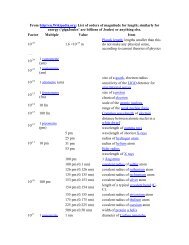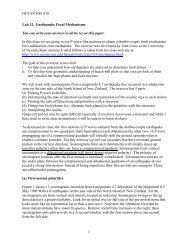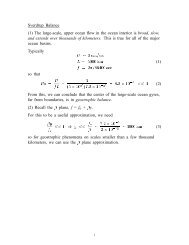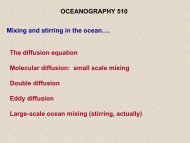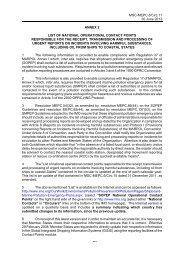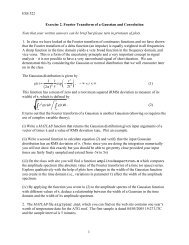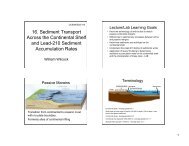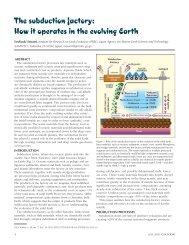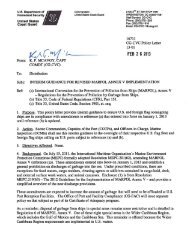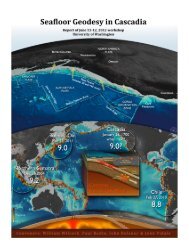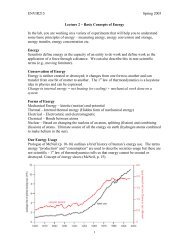LOWER ZAMBEZI RIVER BASIN BASELINE DATA ON LANDUSE ...
LOWER ZAMBEZI RIVER BASIN BASELINE DATA ON LANDUSE ...
LOWER ZAMBEZI RIVER BASIN BASELINE DATA ON LANDUSE ...
You also want an ePaper? Increase the reach of your titles
YUMPU automatically turns print PDFs into web optimized ePapers that Google loves.
CBD.29 The country of Mozambique (801,590 km 2 ) contains a wide diversity of terrestrial,freshwater and marine habitats. However, the biodiversity of Mozambique is poorly known andpoorly documented due to a number of factors including lack of human resources, lack ofopportunities to carry out field-studies during the period of civil unrest and weak institutionalcapacity. A limited amount of data is available for some taxonomic groups, but some pre-wardata especially those dealing with land cover are outdated. Existing knowledge is dispersed overvarious sectoral agencies as well as with individuals in the form of project documents, reports,scientific articles, maps, aerial photographs and satellite imagery. The information has not beenintegrated at the national, local and even in some cases the institutional level. In addition, datasets are based on different classification systems, organized along different formats and are ofvarying accuracy.30. A number of biodiversity mapping and inventory activities have been undertaken, or areunderway. But, as may be expected, in the absence of baseline data, there is little accurateinformation (with a few notable exceptions in National Parks and Game Reserves) regardingtrends in biodiversity and processes or activities threatening biodiversity.31. The five districts are located along the lower Zambezi valley that serves as a biodiversitycorridor from the uplands in Tete Province to the expansive 12,000km 2 Zambezi delta in SofalaProvince. While little is known of biodiversity within the five districts, considerable national andinternational interest focuses on the delta – one of the largest wetland systems in southern Africa.The Zambezi river basin, the largest basin entirely within the SADC region is rich in wetlands.The basin drains a total area of almost 1.4 million km 2 , and wetlands cover almost 66,000 km 2with a total water storage 7 estimated at 100,000 million m 3 . In 2003, the GOM declared theMarromeu Complex of the Zambezi Delta to be the first Wetland of International Importance inMozambique under the Ramsar Convention. The Ramsar Convention is the world’s foremostinternational agreement for the protection and wise use of wetlands, and requires nationalcommitment to the sustainable management of designated wetland sites. The complex is host tomany large mammals and birds 8 . While most conservation management tends to focus on fauna,much less activity is directed to documenting the flora - an exception being the relatively speciesrichGorongosa Reserve further.32. Water resources development projects have substantially altered the hydrological regime ofthe Zambezi Delta and impacted biodiversity 9 . Prior to the construction of Kariba Dam on themiddle Zambezi River, peak floods spread over a mosaic of vegetation communities. Floodplaingrasslands were inundated with floodwaters for up to nine months of the year, with many areasbeing saturated throughout the dry season. With the closure of Kariba Dam in 1959 and CahoraBassa Dam in 1974, nearly 90% of the Zambezi catchment has become regulated so that thenatural flood cycles of the lower Zambezi River cannot be maintained. Flooding events in thedelta, when they occur, now depend on local rainfall-runoff or unplanned (possibly catastrophic)water releases from the upstream dams. These hydrological changes are further exacerbated bythe construction of dikes along the lower Zambezi that prevent medium sized floods up to 13,000m 3/s from inundating the south bank floodplains. The implications for biodiversity in the face ofthese hydrological changes in the delta are profound and must be considered in the context of thehydrogeomorphic processes that control vegetation distribution and abundance. Woody savannaand thicket species have increased in density and colonized far into the floodplain grasslandmosaic. Relatively drought-tolerant grassland species have displaced flood-tolerant species in the7 http://www.sardc.net/imercsa/zambezi/Cep/fsheet16/index.htm8 The International Crane Foundationhttp://www.savingcranes.org/conservation/our_projects/program.cfm?id=239 Timberlake, J. (1998).17



